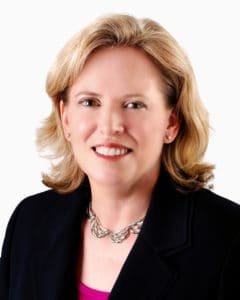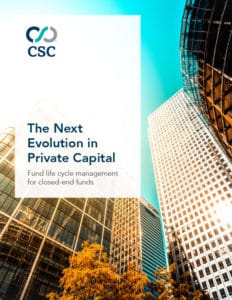Jonathan Watkins: What does the next evolution in private capital look like for closed-end funds, and how did we get to this point?

Anne Anquillare CFA, head of fund services, North America, CSC
Anne Anquillare: It all started with alpha. More specifically, private capital’s ability to deliver alpha. Then the conversation moved onto transparency as we asked, ‘Do we, as an industry, have a commitment to transparency with our investors?’ Now, not only do you have to deliver alpha and transparency, but there needs to be trust between the general partners and their investors. Trust is a bigger lift than customised reporting, but as an industry, I’m sure we can get there.
JW: What is driving this evolutionary change?
Paul Whelan: The capital markets are following a typical maturation cycle of early success leading to more investor demand and growth. This growth has led to increased competition among managers who are vying for the same pool of assets. This, in turn, leads to increased investor scrutiny and sophistication, and also increased regulatory oversight, which is especially evident in Europe.
Institutional investors have continued to increase allocations to private markets at the expense of public markets, and that’s primarily driven by outperformance in the private market sector, where the combined value of private equity transactions in Europe has tripled over the past decade.
JW: Agnes, do the answers just given apply to the Asia-Pacific market?

Agnes Chen, managing director, APAC, CSC
Agnes Chen: In APAC, private equity has been about size. It’s reached about $296 billion in 2021, which is about 30% of the global AUM over the past decade. The AUM focus on this region grew 2.4 times faster than in North America and three times faster than in Europe. The demand is in internet and technology companies, which have contributed to about 48% of deal value.
A lot of the APAC unicorns grew in the past five years, with more than 50% of global unicorn growth represented in APAC, and there’s still a lot of dry powder committed and unallocated waiting to be invested.
JW: Anne, are the North American drivers of this change any different, and how do managers view these other regions?
AA: In North America we’re watching what’s going on in Europe and Asia. What’s going on in these markets has a trickle-down effect in North America, and the impact can be significant because the market here is more competitive and the size of allocations to private equity, private capital, private debt, and all things illiquid are so large.
The other thing that we’re really mindful of is the regulatory oversight and how each region’s regulatory bodies are watching the others. Because of this we’re starting to see some trickle-down regulatory effects in our markets due to the other regions as well as the local regulatory agencies stepping it up.
JW: From the fund manager perspective, how can they prepare for this next evolution in private capital?
AC: There are five core ways to prepare for this evolution. I would say the first thing is to prepare to scale in terms of size and expertise. Secondly, prioritise investor experience, as fund-raising is always a priority for fund managers. Third, develop regulatory agility and ensure regulatory guidelines are always reviewed and updated with new legislation. Fourth, adopt global standards to ensure quality and transparency. And finally, perhaps look at the shift of mindset from a fund-launch mindset to a fund-lifecycle mindset.
JW: Why is the ability to scale important, and how can fund managers become more scalable?
AC: Fund managers will need to be ready to launch larger funds or consider new jurisdictions. To achieve this requires processes and frameworks that can scale without introducing more risks or challenges. Fund managers need a service partner who can support best practices at every step, from fund formation to fund operations to realisation and all the way
to maturity and liquidation.
JW: What does it mean to shift from a ‘fund-launch’ to a ‘fund-lifecycle’ mindset?

Paul Whelan, managing director – depositary services, CSC
PW: In the past, managers could focus primarily on the fund-raising and the launch of the fund. However, competition for allocations and the complexity of the regulatory environment have brought end-to-end fund operations more into the spotlight.
As Anne said, it was once about alpha generation alone, but this is no longer sufficient to attract investors. The scope and intensity of investor due diligence reviews has increased, and investors are looking at the fund manager’s ability to plan and coordinate across the lifespan of the fund and across multiple domains of expertise, including areas such as administration, reporting, investor services, SPV management, and corporate service.
Fund service providers are striving to become global full-service enterprises, primarily through merger and acquisition activity, which is evidenced by more than 100 fund service provider deals taking place in the last 10 years.
JW: It must be important not to forget about the investor experience side of this.
AA: At the end of the day, no matter how much due diligence they do, no matter how much analysis on previous performance and the manager themselves, it is still a leap of faith when they commit to a new fund. That’s where the trust comes in.
PW: We can talk about technology, the digitisation of the investor experience, and onboarding of investors, but I think the key word there was trust. The trust has been built by people and not by technology. The experience the investor gets dealing with people in fund service providers is crucially important.
JW: To conclude, perhaps each of you could just share some final thoughts or parting advice on this matter?
AC: Regulatory compliance, as well as keeping yourself updated, is important every step of the way, because every day things are changing, regulations are coming up, and investors are looking for more answers from fund managers. They require more explanations, and so you need to be prepared.
AA: What we’re seeing is the rapid expansion of the types of investors coming into the private capital market, with the SEC broadening the definition of accredited investors. You hear wealth managers talking a lot with their clients about being able to offer proprietary products, which means private capital in some way customised for their clientele.
So you’re seeing this whole influx of capital coming from a much different source than we saw in the past, coupled with the still very attractive returns that are provided to institutional investors.
PW: We’ve all witnessed how the private capital market has grown incredibly quickly, and we expect that trend to continue and accelerate certainly in Europe over the next five to 10 years.
In Europe we have the European Long-term Investment Funds (“ELTIF”), which will facilitate retail capital flows into private markets. It will also be interesting to see the impact of tokenisation of real assets in the private markets, how the use of blockchain will eliminate paper-based processes and provide an immutable record of fund and asset ownership. The digitalisation of fund service providers, and indeed GPs and investment managers, will continue. To learn more, please visit www.cscgfm.com/lifecycle-report.
To learn more, please visit www.cscgfm.com/lifecycle-report.